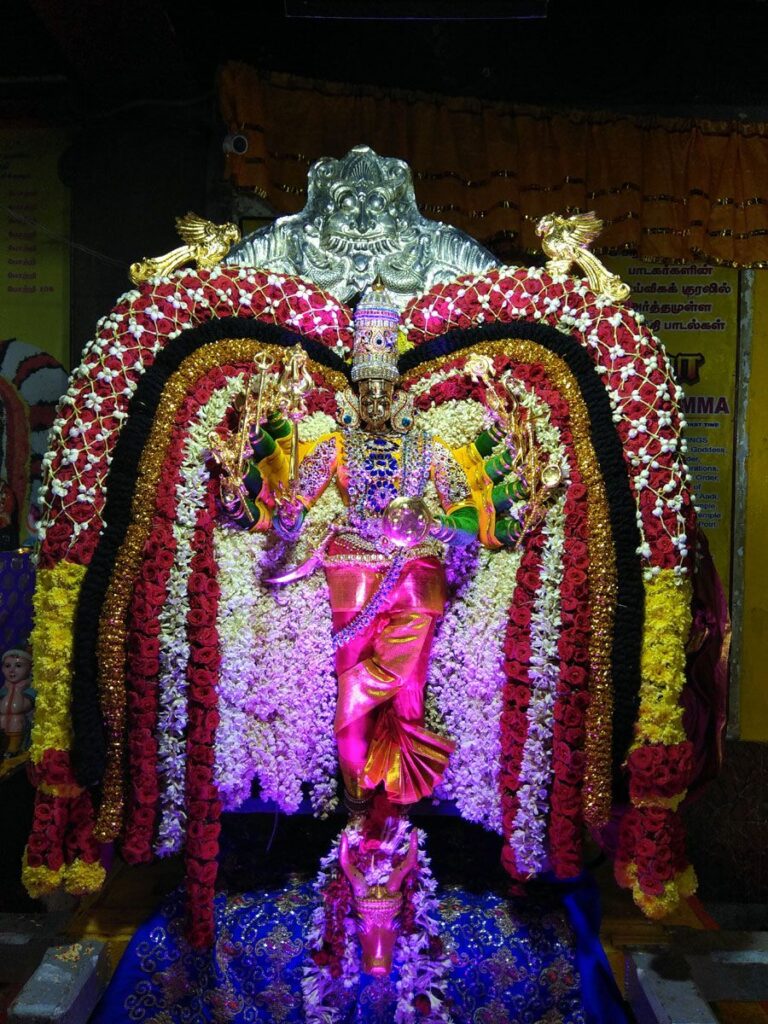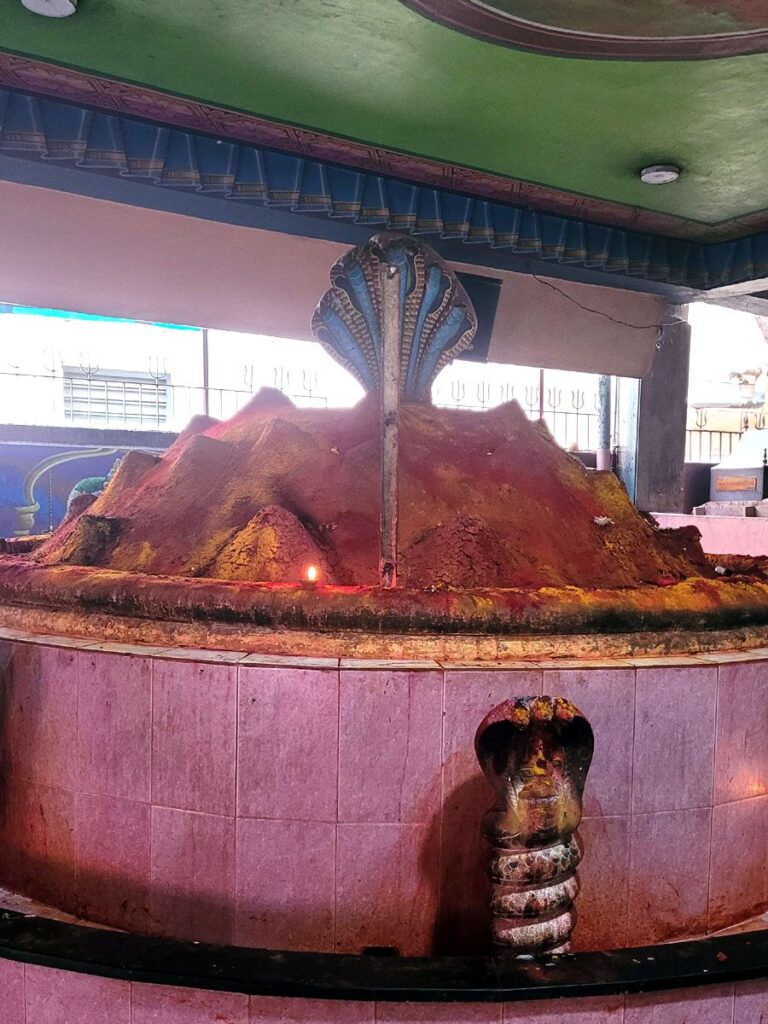Muppathamman Temple Chennai
Muppathamman Temple is a popular Hindu temple located in Chennai, Tamil Nadu. It is dedicated to Goddess Muppathamman, an incarnation of the goddess Parvati, who is revered as a powerful and protective mother figure. The temple attracts many devotees, especially during festivals like Navaratri, when special prayers and celebrations take place.

Contents
- 1 Story of Muppathamman Temple:
- 2 Legend of Muppathamman Temple:
- 3 Significance of Muppathamman Temple:
- 4 Myths & Beliefs of Muppathamman Temple:
- 5 Muppathamman Temple Timing & Rituals:
- 6 Places to visit near Muppathamman Temple:
- 7 FAQ:
- 7.1 Where is the temple located?
- 7.1.1 What are the temple timings?
- 7.1.2 Is there anything unique about the temple?
- 7.1.3 What is the history of the temple?
- 7.1.4 What are the myths associated with the temple?
- 7.1.5 Why are Tuesdays and Fridays considered special?
- 7.1.6 What is Muppathamman worshipped for?
- 7.1.7 What are some things devotees do at the temple?
- 7.1 Where is the temple located?
- 8 How to reach Muppathamman Temple:
Story of Muppathamman Temple:
The Divine Appearance
Many years ago, in a small village that is now part of modern Chennai, the residents were plagued by various misfortunes. They faced natural calamities, illnesses, and the constant threat of evil forces. The villagers prayed fervently to the gods for protection and relief from their troubles.
The Vision of Muppathamman
One night, a devout villager had a divine vision. In his dream, the goddess Parvati appeared, manifesting as Muppathamman, a fierce yet compassionate form. She assured him that she would protect the village from all harm and restore peace and prosperity. The goddess instructed the villager to establish a shrine at a specific spot, promising that her presence there would safeguard the community.
Building the Muppathamman Temple
Inspired by this vision, the villager shared his experience with the others. United by hope and faith, the villagers decided to build a small shrine at the location mentioned in the dream. They installed an idol of Muppathamman and began to offer regular prayers and rituals.
Miracles and Belief
Soon after the shrine was established, the villagers began to notice significant changes. The calamities ceased, illnesses reduced, and a sense of peace and well-being returned to the village. Stories of miraculous healings and fulfilled wishes spread, drawing more devotees to the shrine. People from neighboring areas started visiting, seeking the blessings of the powerful goddess.
Evolution into a Temple
As the number of devotees grew, so did the shrine. Contributions from the community and visiting pilgrims helped in expanding and renovating the structure. The small shrine gradually evolved into a grand temple, complete with intricate carvings and vibrant decorations that are characteristic of South Indian temple architecture.
A Center of Faith and Festivals
The Muppathamman Temple became a central part of the local culture and religious practices. It hosts several festivals throughout the year, with Navaratri being the most prominent. During Navaratri, the temple is adorned with lights and flowers, and special ceremonies are conducted to honor the goddess. Devotees believe that praying to Muppathamman during this festival brings special blessings.
Continued Reverence
To this day, the Muppathamman Temple remains a revered site for worshippers. It stands as a testament to the enduring faith of the people and their belief in the protective power of Muppathamman. The temple not only serves as a place of worship but also as a symbol of hope, healing, and community spirit.
Read More>> Thirukollikadu Saneeswaran Temple

Legend of Muppathamman Temple:
Transformation from Anthill: This legend suggests that the worship of Muppathamman at the site didn’t begin with a temple, but with a simple anthill. Located, perhaps, between an arasu tree (Ficus religiosa) and a neem tree (Azadirachta indica), this anthill was believed to be a sacred spot by locals. Devotees would come and offer their prayers to the anthill, recognizing its spiritual significance.
Over time, this veneration of the anthill is said to have evolved into the worship of Muppathamman, a powerful form of the Divine Mother. The anthill itself might have been seen as a natural manifestation of the goddess’s presence.
Unearthed Idol: Another legend surrounding the temple’s origin focuses on the discovery of an idol. This story suggests that an idol of Goddess Muppathamman was unearthed from the ground, possibly in a field – remember “Muppogam” in Tamil means “field.” This unearthed idol then became the central focus of worship at the site. The name “Muppathamman” itself could be derived from this event, signifying her as the “Amman of the Muppogam” (Goddess of the Field).
Estimated Age: While there’s no confirmed date, many devotees believe the Muppathamman Temple to be over 1,000 years old, signifying its long history as a place of worship.
Read More>> Arulmigu Sri Bannari Mariamman Temple

Significance of Muppathamman Temple:
Devotion to Shakti: The temple is dedicated to Muppathamman, a form of Shakti, the Divine Mother in Hinduism. Devotees seek her blessings for various aspects of life, believing she can remove obstacles, bring prosperity, and fulfill wishes.
Historical Significance: Estimated to be over 1000 years old, the temple stands as a testament to a long tradition of worshipping Muppathamman in the region.
Spiritual Beliefs: There are specific beliefs associated with the Muppathamman Temple:
- Tuesdays and Fridays: Considered particularly auspicious for visiting, with some devotees crawling the temple grounds 108 times as a form of penance or devotion.
- Naga Dosha Relief: Some believe praying here can alleviate the negative effects of “Naga Dosha” (astrological placement of serpents).
- Marriage and Children: Specific rituals involving lemon lamps and garlands are observed on special days, seeking blessings for marriage and children.
Local Tradition: Muppathamman Temple has become a significant part of Chennai’s cultural landscape. The late actress Sridevi’s fondness for the temple is a well-known example of its local importance.
Read More>> Sri Banashankari Temple Bengaluru

Myths & Beliefs of Muppathamman Temple:
- Divine Protection: Devotees believe that Muppathamman provides strong protection against evil forces and negative influences. Many come to the temple seeking her blessings for safety and well-being.
- Healing Powers: The goddess is also believed to have healing powers. People with health issues often visit the temple to pray for recovery and relief from ailments.
- Fulfillment of Wishes: It is a common belief that sincere prayers and offerings to Muppathamman can lead to the fulfillment of desires and aspirations, whether they pertain to personal, professional, or family matters.
- Navaratri Significance: During the festival of Navaratri, special rituals and prayers are conducted at the temple. It is believed that worshipping Muppathamman during this time is particularly auspicious and brings divine blessings.
- Legend of Origin: According to local legend, the temple’s origin is linked to a miraculous event where the goddess appeared to protect the community, leading to the establishment of the Muppathamman Temple in her honor. This story reinforces the belief in her protective and nurturing nature.
Read More>> Gavi Gangadhareswara Temple Karnataka

Muppathamman Temple Timing & Rituals:
Timings:
Generally open from 9:00 am to 9:00 pm.
Tuesdays and Fridays:
Considered especially auspicious days for visiting the temple.
The temple might be a little more crowded on these days.
Rituals:
Regular pujas and abishegams: These are daily worship ceremonies performed by the temple priests.
Devotees performing 108 circumambulations ( प्रदक्षिणा / Pradakshina): This practice is particularly observed on Tuesdays and Fridays. Devotees crawl around the Muppathamman Temple pradakshina path 108 times as an act of penance or intense devotion. 108 is a significant number in Hinduism, symbolizing completeness or auspiciousness.
Places to visit near Muppathamman Temple:
- Marina Beach: One of the longest urban beaches in the world, Marina Beach is a great spot for a relaxing stroll, enjoying the sunset, and tasting local street food.
- Kapaleeshwarar Temple: A historic temple dedicated to Lord Shiva, known for its stunning Dravidian architecture and vibrant festivals.
- Santhome Cathedral Basilica: A beautiful basilica built over the tomb of St. Thomas, one of the twelve apostles of Jesus Christ, featuring neo-gothic architecture.
- Fort St. George: This historic fort, built by the British East India Company, houses a museum showcasing artifacts from the colonial era and the St. Mary’s Church.
- Government Museum: Located in Egmore, it is one of the oldest museums in India, featuring a rich collection of archaeological and numismatic artifacts, as well as a vast array of art.
- Valluvar Kottam: A monument dedicated to the classical Tamil poet and philosopher Thiruvalluvar, known for its impressive chariot structure and beautiful inscriptions of his verses.
- Express Avenue Mall: For those interested in shopping, dining, and entertainment, this modern mall offers a wide range of options.
- Birla Planetarium: An excellent place for science enthusiasts, offering interactive exhibits and shows about astronomy and space science.
- Guindy National Park: A small yet diverse national park in the heart of Chennai, home to various species of flora and fauna, along with a children’s park and a snake park.
- Elliot’s Beach: A quieter alternative to Marina Beach, known for its serene environment and the famous Ashtalakshmi Temple nearby.
FAQ:
Where is the temple located?
The most famous Muppathamman Temple is located in T Nagar, Chennai, near Panagal Park, Griffith Road, Chennai-600017.
What are the temple timings?
The temple is generally open from 9 am to 9 pm.
Is there anything unique about the temple?
Yes, the temple is believed to be over 1000 years old and houses idols of other deities besides Muppathamman.
What is the history of the temple?
There’s no exact documented history, but legends say the worship began with an anthill or an unearthed idol of the Goddess. The temple’s age is estimated to be over 1000 years.
What are the myths associated with the temple?
Myths include the origin from a sacred anthill, the unearthing of the idol, and the belief that Muppathamman fulfills wishes and protects devotees.
Why are Tuesdays and Fridays considered special?
These days are considered auspicious for visiting the temple. Some devotees perform a devotional act by crawling the temple premises 108 times on these days.
What is Muppathamman worshipped for?
Devotees believe praying to Muppathamman brings relief from troubles, fulfills wishes, and cures ailments, especially related to children’s health.
What are some things devotees do at the temple?
Devotees offer prayers, some perform the 108-crawl ritual on Tuesdays and Fridays, and some offer special lamps or wear lemon garlands for specific blessings.
How to reach Muppathamman Temple:
By Air:
- Chennai International Airport (MAA): The temple is about 20 km from the airport. You can take a taxi or use ride-sharing services to reach the Muppathamman Temple directly.
By Train:
- Chennai Central Railway Station: Located around 10 km from the temple, you can hire a taxi or an auto-rickshaw, or use ride-sharing services to get there.
- Chennai Egmore Railway Station: About 8 km away, similar transportation options are available from here as well.
By Bus:
- Metropolitan Transport Corporation (MTC) Buses: Chennai has a well-connected bus network. Look for buses heading towards Mylapore, Mandaveli, or Adyar, as these routes typically pass near the temple.
- Nearest Bus Stop: Check for the nearest stop to Muppathamman Temple and take a short walk or auto-rickshaw from there.
By Metro:
- Chennai Metro Rail: The nearest metro station is Teynampet on the Blue Line. From there, you can take an auto-rickshaw or a taxi to the Muppathamman Temple.







One Comment